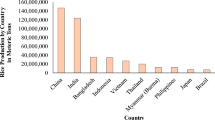Abstract
Fossil energy depletion and growing environmental concerns have brought up increasing interest in bio-based eco-efficient and high technology materials. Among them, starch nanocrystals (SNC) consist of crystalline nano-platelets produced from the hydrolysis of starch and mainly used as nano-fillers in polymeric matrix. New applications have brought up the need for scaling-up the SNC preparation process. However, for this new bio-based nano-material to be sustainable, its preparation and processing should have limited impacts on the environment. Thus, together with analyzing and making recommendations for the scaling-up of SNC production process, it is worth identifying “environmentally sensitive” steps using life cycle analysis (LCA). To that purpose, different scenarios have been proposed and compared according to different environmental impacts. Also, a comparison to its main competitor, i.e. organically modified nanoclay (OMMT), is proposed. From a LCA point of view, SNC preparation requires less energy than OMMT extraction, but global warming and acidification indicators were higher than for OMMT. However, SNC have the added advantages to be renewable and biodegradable contrary to OMMT which contribute to non-renewable energy and mineral depletion. Thus, used as filler, SNC have a positive impact on the end of life of the filled material. From these observations, recommendations for the scaling-up of the SNC preparation process are made and deal mainly with the use of land and water.










Similar content being viewed by others
References
Geraci CL (2011) 2011 TAPPI Intl Conf Nano Renew Mater
Habibi Y, Lucia L, Rojas O (2010) Chem Rev 110(6):3479–3500
Paillet M, Dufresne A (2001) Macromolecules 34(19):6527–6530
Gopalan Nair K, Dufresne A (2003) Biomacromolecules 4(3):666–674
Morin A, Dufresne A (2002) Macromolecules 35(6):2190–2199
Le Corre D, Bras J, Dufresne A (2010) Biomacromolecules 11(5):1139–1153
Angellier H, Choisnard L, Molina-Boisseau S, Ozil P, Dufresne A (2004) Biomacromolecules 5:1545–1551
Putaux JL, Molina-Boisseau S, Momaur T, Dufresne A (2003) Biomacromolecules 4(5):1198–1202
Chen G, Wei M, Chen J, Huang J, Dufresne A, Chang PR (2008) Polymer 49(7):1860–1870
Chen Y, Cao X, Chang PR, Huneault MA (2008) Carbohydr Polym 73(1):8–17
Yu J, Ai F, Dufresne A, Gao S, Huang J, Chang PR (2008) Macromol Mater Eng 293(9):763–770
Garcia NL, Ribba L, Dufresne A, Aranguren MI, Goyanes S (2009) Macromol Mater Eng 294(3):169–177
Namazi H, Dadkhah A (2008) J Appl Polym Sci 110(4):2405–2412
LeCorre D, Bras J, Dufresne A (2011) Macromol Mater Eng. doi:10.1002/mame.201100317
Angellier H, Molina-Boisseau S, Lebrun L, Dufresne A (2005) Macromolecules 38(9):3783–3792
Bras J, Hassan ML, Bruzesse C, Hassan EA, El-Wakil NA, Dufresne A (2010) Ind Crops Prod 32(3):627–633
Kümmerer K, Menz J, Schubert T, Thielemans W (2011) Chemosphere 82(10):1387–1392
Lin N, Huang J, Chang PR, Feng L, Yu J (2011) Coll Surf B Biointerf 85(2):270–279
Zhang X, Huang J, Chang PR, Li J, Chen Y, Wang D, Yu J, Chen J (2010) Polymer 51(19):4398–4407
Valodkar M, Thakore S (2011) Carbohydr Res 345(16):2354–2360
Bruntland G (1987) Our common future. The world commission on environment and development. Oxford University Press, Oxford
Johansson C, Järnstrom L, Breen C (2010) WO/2010/077203
ISO 14040 (1997) Environmental management—life cylce assessment—principles and framework. ISO 14040:1997(E)
Goedkoop M, Oele M, Schrywer Ad, Vieira M (2008) SimaPro database manual—Methods library
Actu Environnement (2003) Dictionnaire Encyclopedique—Definition de Acidification COGITERRA 16/07/2011
Truhaut R (1977) Ecotoxicol Environ Saf 1(2):151–173
Franklin Associates (2006) Chem Eng, 15 March 2006 (pers commun)
Zuckerforschung Tulln (2009) Maize starch extraction http://www.zuckerforschung.at/inhalt_en.php?titel=STARCH%20TECHNOLOGY&nav=nstaerkeinfo_en&con=cigsmais_en
Gold MV (2007) What is organic production? USDA Definition and Regulations USDA September 2011 http://www.nal.usda.gov/afsic/pubs/ofp/ofp.shtml
USDA (2006) Organic Foods August 2011 http://usda-fda.com/articles/organic.htm
Pimentel D, Hepperly P, Hanson J, Seidel R, Douds D (2005) Organic and conventional farming systems: environmental and economic issues
DeBenedetti B, Camino G, Tabuani D, Maffia L, Santarén J, Aguilar E (2006) STRP European research program “NANOFIRE”, No. 505637, 6th Framework Program Comparison between eco-profiles of innovative nanoclay and traditional TBBPA flame retardants
Hohenthal C, Veuro S, Kuisma M (2011) D6.6: sustainability assessment for renewable biopolymer based flexible packaging paper http://www.flexpakrenew.eu/documentation.cfm
Hohenthal C, Veuro S (2011) FlexPakRenew workshop
LeCorre D, Bras J, Dufresne A (2011) Carbohydr Polym 86(4):1565–1572
LeCorre D, Bras J, Dufresne A (2011) Surf Coat Technol (submitted)
Vilaplana F, Strömberg E, Karlsson S (2010) Polym Degrad Stab 95(11):2147–2161
Fleischer T, Grunwald A (2008) J Clean Prod 16(8–9):889–898
Lordan S, Kennedy J, Higginbotham C (2011) Appl Toxicol 31(1):27–35
Kovacs T, Naish V, O’Connor B, Blaise C, Gagné F, Hall L, Trudeau V, Martel P (2010) Nanotoxicology 4(3):255–270
Foster EJ, Clift MJD, Rothen-Rutishauser B, Weder C (2011) 2011 TAPPI Intl Conf Nano Renew Mater
Villanova JCO, Ayres E, Carvalho SM, Patrício PS, Pereira FV, Oréfice RL (2011) Eur J Pharm Sci 42(4):406–415
Author information
Authors and Affiliations
Corresponding author
Rights and permissions
About this article
Cite this article
LeCorre, D., Hohenthal, C., Dufresne, A. et al. Comparative Sustainability Assessment of Starch Nanocrystals. J Polym Environ 21, 71–80 (2013). https://doi.org/10.1007/s10924-012-0447-0
Published:
Issue Date:
DOI: https://doi.org/10.1007/s10924-012-0447-0




